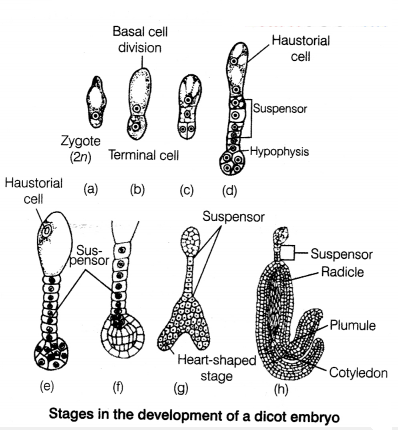CBSE Sample Papers for Class 12 Biology Set-4
Class 12thCBSE Sample Papers for Class 12 Biology Set-4
CBSE Sample Papers for Class 12 Biology Set 4 with Solutions
Time : 3 Hours
Maximum Marks : 70
General Instructions:
- All questions are compulsory.
- The question paper has five sections and 33 questions. All questions are compulsory.
- Section-A has 16 questions of 1 mark each; Section-B has 5 questions of 2 marks each; Section-C has 7 questions of 3 marks each; Section-D has 2 case-based questions of 4 marks each; and Section-E has 3 questions of 5 marks each.
- There is no overall choice. However, internal choices have been provided
in some questions.
A student has to attempt only one of the alternatives in such questions. - Wherever necessary, neat and properly labelled diagrams should be drawn.
Section A
Question 1.
Lactational amenorrhea as a means of contraception refers
to
(a) absence of menstruation since ovulation does not occur during
breastfeeding
(b) reduced efficiency of pregnancy hormones
(c) unsuitable
uterus
(d) suppressed sperm motility
Answer:
(a) Lactational amenorrhea
is described as a natural method of contraception. This is based on the fact
that the menstrual cycle does not occur during the period of intense lactation
following parturition.
Question 2.
When alleles of two contrasting characters are present
together and one of the character expresses itself during the cross while the
other remains hidden gives the
(a) law of purity of gametes
(b) law of
segregation
(c) law of dominance
(d) law of independent assortment
Answer:
(c) law of dominance
Question 3.
Given below are some chromosomal abnormalities and the
chromosomal complement.
| Chromosomal abnormalities | Chromosome complement |
| A. Down’s syndrome | 1. Trisomy 21 |
| B. Klinefelter’s syndrome | 2. 44+OX |
| C. Edward’s syndrome | 3. Trisomy 18 |
| D. Turner’s syndrome | 4. 44 + XXY |
How many of the above pair are correctly matched?
(a) 1
(b) 2
(c)
3
(d) 4
Answer:
(b) 2
Question 4.
The presence of both a leading and a lagging strand is
observed during DNA replication. This is because
(a) RNA primers are not
sufficient enough to facilitate replication of both strands
(b) only one DNA
template is available for reading at a time
(c) DNA polymerase can catalyse
synthesis of one strand at a time
(d) DNA polymerase reads only in 5′ – 3′
direction
Answer:
(d) Since, DNA polymerase reads only in 5′ – 3′
direction, it can replicate the strand with 3′ – 5′ orientation continuously,
which is called the leading strand. On the strand with 5′ – 3′ polarity, DNA
replicates in fragmented manner. This is the lagging strand. Thus, both the
leading and lagging strands are present together during DNA replication.
Question 5.
Transgenic animals are generally created for a variety of
medical reasons except
(a) for testing vaccine safety
(b) for
manufacturing of physiologically important proteins
(e) stimulation of
pathogenicity
(d) for toxicity tests
Answer:
(c) Transgenic animals are
created by introducing a foreign genes in animals. These are created for
following benefits
(i) Study of biological effects of new proteins.
(ii)
Understanding the role of genes in development of diseases.
(iii) Testing
safety of new drugs, vaccines or other proteins, chemicals, etc.
They are
never used in stimulation of pathogenicity.
Hence, option (c) is
incorrect.
Question 6.
The free-living fungus Trichoderma can be used for
(a)
killing insects
(b) biological control of plant disease
(c) controlling
butterfly caterpillars
(d) producing antibiotics
Answer:
(b)
Trichoderma species are free-living fungi. They are effective biocontrol agents
of several plant pathogens like Fusarium, Phytopthora, etc. and used in the
treatment of plant disease.
Question 7.
Which of the following is an example of ex situ conservation
strategy?
(a) Biosphere reserves
(b) Sacred groves
(c) Hotspots
(d)
Zoological park
Answer:
(d) Ex situ conservation involves protecting an
organism outside its habitats by perpetuating sample population in resource
centres. For example, a zoological park where wild animals are protected and
also exhibited for public viewing.
Question 8.
The restriction enzyme responsible for the I|| cleavage of
following sequence is
5′ – GTCGAC – 3′
3′ – CAGCTG – 5′
(a) Alu I
(b) Hind III
(c) Hind II
(d) Eco RI
Answer:
(c) Hind II
Question 9.
Given below are some statements derived from Darwin’s theory
of evolution. Select the one, which is incorrect.
(a) Darwin’s variations
were small and directional
(b) Fitness is the end result of the capability of
an individual to get selected by nature
(c) New species evolves from
ancestral forms by the struggle for limited resources
(d) Abrupt and drastic
changes cause speciation
Answer:
(d) Statement given in option (d) is
incorrect and can be corrected as
The abrupt and drastic changes are called
as mutation. These changes are inheritable and results in speciation. This was
not a part of Darwin’s theory of evolution.
Question 10.
Which one of the following pair of microbes and their
function is correctly matched?
| Microbes | Functions |
| (a) Rhizobium | Parasite in roots of leguminous plants |
| (b) Mycorrhiza | Mineral uptake from the soil |
| (c) Azospirillum | Symbiotic N2-fixing bacteria |
| (d) Frankia | Biocontrol for several species of insects |
Answer:
(a) Rhizobium fixes nitrogen for leguminous plants. They live in a
symbiotic relationship within the roots of such plants.
Question 11.
The table below highlights differences between PCR and gene
cloning. Which of the following options highlight a correct different?
| Characteristics | Gene cloning | PCR |
| (a) Efficiency | More | Less |
| (b) Manipulation | Both in vivo and in vitro | In vivo only |
| (c) Error probability | More | Less |
| (d) Materials required | Different enzymes, vectors, bacterial host, etc. | Only the gene of interest and subject |
Answer:
(c) In PCR, the probability of errors is lesser compared to gene
cloning because the latter is completely
Question 12.
Study the given figure carefully.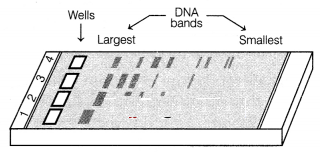
A fragment of DNA molecule on cutting with restriction enzyme yielded 4
fragments of sizes 3 kb, 2.5 kb, 8 kb and 6.7 kb.
Having become an expert on
gel electrophoresis, you are asked to examine a gel. Identify where would you
find these segments of DNA.
| DNA fragments | Location |
| (a) 3kb | Near the positive electrode, farthest from wells |
| (b) 6.7kb | Near the negative electrode, close to wells |
| (c) 8kb | Near the positive electrode, farthest from wells |
| (d) 25kb | In middle, stones down afte few minutes |
Answer:
(a) Gel electrophoresis separates the fragments of DNA on the
basis of size, shape, molecular weight, . etc. Since, DNA has negative charge,
the fragments move toward the anode. The smaller fragments move faster due to
lesser friction, while larger fragments move slowly. Thus, the location of 3 kb
is correct, as it will present nearest to the anode, i.e. near to positive
electrode and farthest from well.
Question Nos. 13 to 16 consist of two statements, Assertion (A) and Reason
(R). Answer these questions by selecting the appropriate option given below.
(a) Both Assertion and Reason are true and Reason is the correct explanation of
Assertion
(b) Both Assertion and Reason are true, but Reason is not the
correct explanation of Assertion
(c) Assertion is true, but Reason is
false
(d) Assertion is false, but Reason is true
Question 13.
Assertion (A) : Our immune system always recognise the ‘self
cells’ and destroys the foreign proteins.
Reason (R) : When the system fails
to recognise the ‘self’ from ‘non-self’, it
starts destroying the body’s own
proteins. This is known as autoimmunity.
Answer:
(b) Both Assertion and
Reason are true, but Reason is not the correct explanation of Assertion.
Our
immune system has the ability to distinguish between self and non-self cells.
Because every cell in the body has the presence of antigens. These antigens are
particular and differ from one organism to another.
Due to this, when the immune cells detect any other antigen a part from self antigen, they quickly initiate immune responses in the body.
Question 14.
Assertion (A) : The distance between two polynucleotide
chains in DNA remains almost constant.
Reason (R) : A purine is paired with
pyrimidine with hydrogen bonds.
Answer:
(a) Both Assertion and Reason are
true and Reason is the correct explanation of Assertion.
The distance between
two polynucleotides is almost constant because the purines always paired with
pyrimidine with hydrogen bonds, i.e. Adenine always form two hydrogen bonds with
Thymine (A = T) similarly Guanine always form three hydrogen bonds with cytosine
(G ≡ C ).
Question 15.
Assertion (A) : Constant gene frequencies over several
generations indicate an absence of evolutionary progress.
Reason (R) :
Evolution occurs when genetic equilibrium is absent.
Answer:
(a) Both
Assertion and Reason are true and Reason is the correct explanation of
Assertion.
Constant gene frequencies (p2 + 2pq + q2 = 1) over several generations indicate that evolution is not taking place in the population.
For evolutionary progress, changes in gene frequencies is essential, this constant equilibrium is changed by random mating, mutation, gene flow, genetic drift and genetic recombination.
These processes introduce variations in a population which serves as raw material for evolution.
Question 16.
Assertion (A) : Meiosis is the cell division which occurs in
the sexually reproducing organisms.
Reason (R) : Meiotic cell division
results into two cells having exactly same genetic makeup.
Answer:
(c)
Assertion is true, but Reason is false. Reason can be corrected as
In
meiosis, the resultant cells do not have exactly same genetic makeup due to the
process of crossing over.
Section B
Question 17.
A cross is made between a tall plant with yellow seeds
(genotype-TtYy) and a tall plant with green seeds (genotype – Ttyy).
What
will be the proportions of phenotypes of their offspring in F1?
Answer: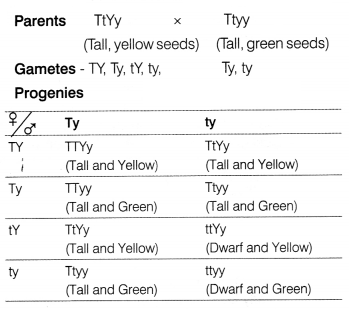
Question 18.
In the figure below, the process of recombinant DNA
technology is depicted.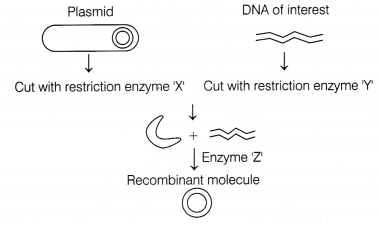
(i) What is the role of enzyme Z in the above experiment?
(ii) Will the
outcome of this experiment be successful? Give your opinion along with your
answer.
Answer:
(i) Enzyme Z joins the foreign DNA to plasmid.
(ii) The restriction enzymes cut the DNA strands in the centre of their
palindromic restriction sites. This creates single-stranded unpaired bases, i.e.
sticky ends.
These ends can form hydrogen bonds with their complementary cut
counter parts. For RDT, this is necessary to form a recombinant molecule. To
achieve this both the vector DNA and DNA/gene of interest is cut with same
restriction enzymes which is not done in this experiment. Hence, this experiment
will not yield successful results.
Question 19.
The diagram shows the changes that takes place in the
endometrium during a normal menstruation.
Identify A and B, also elaborate
the level of the FSH and LH during the phase B.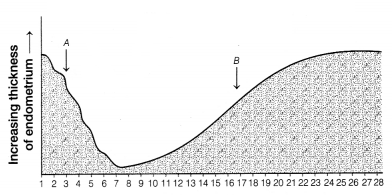
Answer:
‘A’ in graph represent menstruation whereas ‘B’ represents
ovulation.
During the ovulation phase both FSH and LH levels attain a peak
level.
Question 20.
Study the flowchart given below.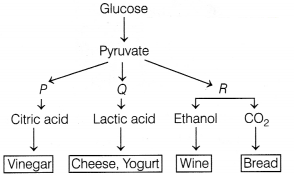
(i) With reference to the above flowchart identify P, Q and
R.
(ii) All these products derived from microorganisms have one procedure is
common identify it.
Answer:
(i) P is bacteria – Aspergillus niger
Q is
bacteria – Lactobacillus
R is yeast – Saccharomyces cerevisiae
(ii) All these products are produced via fermentation, a metabolic process that brings chemical changes in organic substrates in the presence of beneficial microbes.
Question 21.
The density of a population in any given habitat during a
specific period fluctuates. These changes are associated with phenomenon A and B
as shown below.
(i) What are A and B?
(ii) How do A and B affect the
population density?
Or
Discuss one example based on your day to day
observations, showing how loss of one species may lead to the extinction of
another.
Answer:
(i) A is natality or immigration.
B is mortality or
emigration.
(ii) Natality is the rate of production of new individuals per unit of
population per unit time.
Immigration is permanent inward movement of
individuals into a habitat.
Both these processes add to the size of
population.
Mortality is the number of deaths per unit time.
Emigration is
the permanent outward movement of individuals from their habitat to elsewhere.
Both these processes decrease the size of a population.
Or
Co-extinction
is the extinction of two mutually related or inter-related species, for instance
a fast fish extinction leads to the extinction of all those parasites
exclusively found on it. Another example is plant pollinator where extinction of
one leads to the extinction of other.
Section C
Question 22.
Given below figure depicts a disease. Observe it carefully
and answer the questions that follows.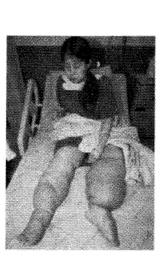
(i) Identify the disease and its causative agent. Can this
disease be transmitted directly by coming in contact with infected person.
Support your answer with a brief explanation.
(ii) Suggest any two preventive
measures in order to reduce the incidence of this infection.
Answer:
(i)
The diagram showing elephantiasis which is caused by Wuchereria bancrofti.
No, this is a vector mediated infection. When mosquitoes carrying the immature larvae called microfilariae bites a person, these larvae enter the body and develop in the lymph nodes and it does not transmit by direct contact with infected person.
(ii) Preventive measures are
(a) Maintain hygiene in surroundings.
(b)
Mosquito breeding grounds should be destroyed, since these are vectors which
transmit this disease.
Question 23.
Explain the levels of biodiversity at genetic, specific and
ecological levels with the help of one example each.
Answer:
Genetic
diversity A single species shows diversity at the genetic level over its
distributional range. For example, the genetic variation showed by the plant
Rauwolfia vomitoria growing in the different Himalayan ranges might be in terms
of the potency and concentration of reserpine.
Species diversity It is the diversity at the species level or the measure of the variety of species and their relative abundance with the region. For example, the Western Ghats have a greater amphibian species diversity than the Eastern Ghats.
Ecological diversity At the ecosystem level, India shows diversity with its deserts, rainforests, mangroves, coral reefs and alpine meadows.
Question 24.
The DNA is packed in the nucleus. It is placed their in
supercoiled fashion in order to take less space in it. Otherwise if a human DNA
is stretched out from the cell it would be about 2m long. Similarly, other
prokaryotes also have DNA with different length.
(i) Calculate the length of DNA in a human diploid cell. Also explain if in
prokaryotes, the length of their DNA is far longer than their body size, then
how does their DNA fit in such a small space?
(ii) In a nucleosome, how do
histones acquire positive charge?
Answer:
(i) The length of DNA would
be
DNA in prokaryotes is found in the cytoplasm in a super coiled stage. This
coiled state is maintained by RNA and non-histone proteins called
polyamines.
(ii) Histone proteins acquiring positive charge depending upon the abundance of amino acid • residues, i.e. lysine and arginines with charged side chains.
Question 25.
Observe the given below diagram and answer the questions that
follows.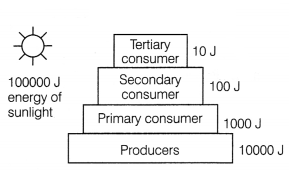
(i) Energy is lost as heat at each step of trophic level.
What does it depicts ?
(ii) Can a given species occupy more than one trophic
level in the same ecosystem at the same time? Enlist any two limitations of
ecological pyramids.
Answer:
(i) Pyramid of energy states the relationship
between the producers and consumers in an ecosystem in terms of flow of energy.
Thus, it is always upright.
(ii) Yes, a sparrow is a primary consumer when it eats seeds, fruits, peas
and a secondary consumer when it eats insects and worms.
The two limitations
of ecological pyramids are as follows
(a) It does not take into account the
same species belonging to two or more trophic levels.
(b) It assumes a simple
food chain, which never exists in nature.
Question 26.
Explain enzyme replacement therapy to treat adenosine
deaminase deficiency. Mention two disadvantages of this procedure.
Answer:
Adenosine deaminase deficiency is a genetic disorder. The disorder is
caused due to the deletion of the gene for adenosine deaminase, the enzyme
crucial for the immune system to function.
Adenosine deaminase deficiency in patients can be treated by enzyme replacement therapy. In this treatment, patients are regularly injected with the functional ADA enzyme.
Disadvantages of this process
(i) It does not completely eradicate the
disease
(ii) The requirement of repeated doses of the enzyme makes it
expensive.
Question 27.
cry I Ac and cry II Ab are introduced in a plant to prevent
infestation by cotton bollworms.
(i) What would be the result of this
process?
(ii) Summarise the action of this gene in the host it is introduced
into.
Or
At the murder spot of Raghav, police investigating team found
small spots of blood. They collected the sample with the help of forensic team,
who performed a PCR test. This test become an important evidence for police to
crack the case.
(i) (a) What is PCR?
(b) Name any two fields where PCR is
used.
(ii) What is the denaturation process?
Answer:
(i) By introducing
cry I Ac and cry II Ab genes, the host will become resistant to infestation by
bollworms, e.g. Bt cotton.
(ii) The Bt gene derived from the bacterium Bacillus thuringiensis codes for
the Cry protein, which normally exists in an inactive form. As soon as the
target insect feeds on the Bt cotton, the toxic protein produced in the plants,
gets converted into its active form due to alkaline pH of the gut of insect.
The activated protein then binds to the surface of insect’s midgut and creates
pores that cause swelling, lysis and eventually death of the insect.
Or
(i) (a) PCR stands for Polymerase Chain Reaction, This process
multiplies copies of the gene of interest and synthesised in in vitro.
(b)
PCR is used in medical and forensic applications,
(ii) Denaturation is the first step of PCR in which DNA strands gets denatured.
Question 28.
Flowering plants have developed many devices to discourage
self-pollination and to ‘ encourage cross-pollination. Explain three such
devices.
Answer:
The mechanisms/processess that plants use to avoid
self-pollination are known as outbreeding devices.
The three outbreeding devices that flowering plants have developed to
discourage self-pollination are
(i) Unisexuality : (Dicliny) Flowers are
unisexual, so that self-pollination is not possible. These plants may be
monoecious (bearing both male and female flowers, e.g. maize) or dioecious
(bearing male and female flowers on different plants, e.g. mulberry,
papaya).
(ii) Dichogamy Anthers and stigmas mature at different times in a bisexual
flower for preventing self-pollination.
(a) Protandry : Anthers mature
earlier than stigma of the same flower. The pollen thus become available to
stigmas of the older flowers, e.g. sunflower, Salvia.
(b) Protogyny : Stigmas
mature earlier, so that they get pollinated before the anthers of the same
flowers develop pollen grains, e.g. Mirabilis jalapa, Gloriosa, Plantago.
(iii) The third device to prevent self-pollination is self-incompatibility. It is a genetic mechanism that prevents self-pollen from fertilising the ovules by preventing pollen germination or pollen tube growth in the pistil. All these methods encourage cross-pollination thus, causing genetic variations among them.
In flowering plants cross-pollination is preferred because it brings variation which helps the plants to defend against diseases and increase their survival rate.
Section D
Q. Nos. 29 and 30 are case-based questions. Each question has 3 subparts with
internal choice in one
subpart.
Question 29.
Study the figure of a floating hydrophyte plant that grows in
water bodies.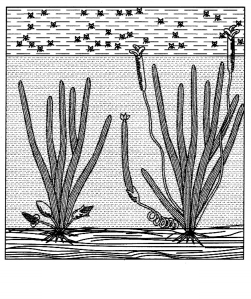
(i) On the basis of your knowledge about pollination,
identify the mechanism of pollination in this plant.
(ii) This type of
pollination mechanism is quite rare, limited to around 30 genera. The plants
exhibiting this mechanism must have some special
characteristics. Describe
these characteristics. (Any 2)
(iii) If a plant has pollen grains, small,
light dry, dusty and non-sticky and winged, while stigma – large, hairy and
feathery, will they use a similar mechanism for exchanging gametes?
Or
(iii) If a plant has to get pollinated by insect, what characteristics should it
exhibit?
Answer:
(i) The plant is Vallisneria, where the flowers are borne
underwater. For pollination, water is required as the agency/medium. This
mechanism is known as hydrophilly.
(ii) Specific features associated with water pollinated plants are
(a)
stigma are long and sticky.
(b) pollen grains are long, ribbon like and
coated by a mucilaginous covering.
(iii) A plant with small, light, dry, non-sticky pollens and large, hairy,
feathery stigma are adapted to get pollinated by wind. This mechanism is known
as anemophily.
Or
(iii) (a) Insect pollinated flowers should be large,
colourful and fragrant.
(b) Flowers have nectar glands, which secrete nectar
to attract pollinators for feeding.
Question 30.
In order to build a longitudinal dataset a record of adult
finches Geospiza fortis living on one of the Galapagos islands was created. The
data collected was associated with the variations in beak shape of birds. The
records taken between 1981 – 2020 are shown in the graph.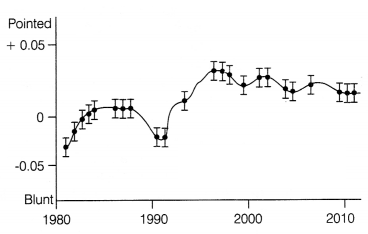
(i) What lead to the diversity in beak shape among the finches?
(ii) The
graph as a whole does not represent any evolutionary changes in the beaks since
time interval is too small, where evolutionary progress can take thousands of
years to occur. Is the above observation correct? Discuss your opinion on
this.
(iii) Galapagos finches affort an excellent example of adaptive
radiation. Comment.
Or
(iii) ‘Homology results in
divergence’.
Elaborate.
Answer:
(i) The diversity in the beak shape is
most probably due to changes in environment which lead to natural selection and
gene flow among species.
(ii) The graph indicate evolutionary change. It has been verified that evolution can occur with surprising speed based on selection pressures. The selection in case of finches was strong and new populations evolved within a matter of generations.
(iii) Galapagos finches affort an excellent example of adaptive radiation
where an organism adapts to new ecological contexts. It is assumed that a stock
of ancestral finches reached the islands from the mainland in the absence of
much competition, evolved to fill many of the empty ecological niches during
which their beaks changed in size and morphology as an adaptation towards
different diets.
Or
(iii) In divergent evolution, a same basic organ
becomes adapted by specialisation to perform different functions in order to
adapt to different environmental conditions in their habitat. Such organs are
called as homologous.
Section E
Question 31.
According to the survey conducted by UNODC, Ministry of
Social Justice and Empowerment Government of India, AIIMS, following data is
collected.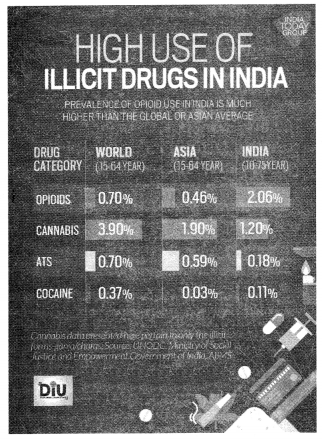
Observe the data and explain how does a person comes to a situation where he/she
gets addicted to a drug without consciously doing so?
Also, describe the
strategy you will plan, in order to wean off your fellow classmate who you
suspect has started taking drugs.
Or
Given below are following symptoms of
disease. Read them carefully and identify the disease and the causatives
agent.
| No. | Symptoms of diseases | Diseases | Causative agents |
| 1. | Stools with excess mucus and blood clots. | ||
| 2. | Blockage of intestional passage, internal bleeding and muscle pain. | ||
| 3. | Alveoli get filled with fluid, fever. | ||
| 4. | High fever, stomach pain, loss of appetite. | ||
| 5. | Bouts of fever, diarrhoea, weight loss, decrease no. of T-lymphocytes. |
Answer:
Addiction starts with periodic or repeated consumption of a drug
which was initially prescribed for the treatment of a medical condition.
However, the effect of these drugs, make people with dependent on them.
Sometimes people start using drugs for fun, under peers pressure or during
extremely stressed periods. People usually become dependent on drugs because of
the affect they have on brain. They imitate brain chemicals or induce the brain
to release larger amounts of naturally occurring chemicals.
Treatment of any addiction is called deaddiction. In order to help my friend
to wean off from drug abuse, first I will talk to him. We will try to discuss
the problems or situations in his life, which are pushing him towards drug use.
Gradually parents, teachers can get involved. Along with this therapy can also
help him with deaddiction or counselling.
Or
(i) Amoebiasis is caused by
Entamoeba histolytica. It is a protozoan parasite in the large intestine of
human. Its symptoms include constipation, abdominal pain, stool with excess
mucus and blood clots.
(ii) Ascariasis is a nematode disease caused by Wuchereria. Its symptoms include internal bleeding, muscular pain, blockage of intestinal passage, etc.
(iii) Pneumomia is a bacterial disease caused by Streptococcus pneumoniae. Its symptom include fever, chills, alveoli filled with fluid, etc.
(iv) Typhoid is a bacterial disease caused by Salmonella typhi. Its symptoms include high fever (39° to 40°), weakness, stomach pain, constipation, loss of appetite, etc.
(v) AIDS is a viral disease caused by Human Immuno deficiency Virus (HIV). Symptoms of this disease include decrease in the number of helper T-lymphocyts, bouts of fever, diarrhoea, etc.
Question 32.
Study the graph shown below.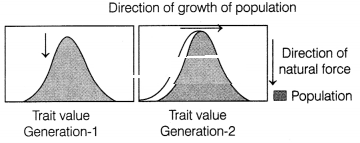
(i) Based on the graph, it appears that there is a selective pressure on the
species under study to change according to the environmental changes. Provide an
example in support of the above observation.
(ii) Phenotypes are raw material
for natural selection. Why so?
Or
Study the given pedigree chart showing
the inheritance pattern of blood group in a family and answer the following
questions.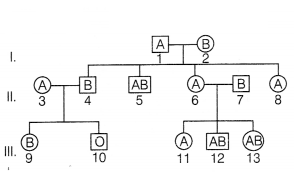
(i) Give the possible genotypes and phenotypes of the
individual 1, 2, 3 and 4.
(ii) Which antigen(s) will be present on the plasma
membranes of RBCs of individual 5 and 10?
(iii) Among the individuals in
generations-II and III, who can be used as
(a) donor for any recipient?
(b) recipient for any donor. Give reason for your answer.
Answer:
(i) The
graph represents the selection of modification . or change in favour of one
extreme while eliminating the other. This can be verified by studying the
example given below Industrial melanism It refers to the evolution of dark body
colour in animal species that live in habitats blackened by industrial soot. The
occurrence of industrial melanism is closely associated with the progress of the
industrial revolution in Great Britain during the 19th century. The peppered
moth (Bistort betularia) existed in two varieties, i.e. light-coloured (white)
and dark coloured (black). Before the emergence of industrialisation, the white
moth were numerous than dark moth in Britain.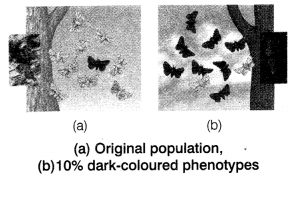
However, after industrialisation, i.e. in 1920, the condition
was reversed. This was because the white moth were easily spotted by predators
on soot covered tree trunks, so there population decreased due to increased
predation and the population of black moths increased. We can also say that
black moths got naturally selected.
However, no variant was completely wiped
out.
(ii) Phenotypes indirectly adapts a population to its environment by
selecting and maintaining favourable genotypes in their gene pool. And the
process of natural selection acts on the phenotype along with the physical,
biochemical and behavioural traits of an organism. Thus, it can be said that
phenotypes are raw material for natural selection.
Or
(i) Possible
genotypes and phenotypes of individual 1,3 and 4 are as follows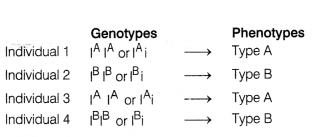
(ii) Individual 5 – Phenotype – AB
Antigen – A and B, Genotype –
|A|B
Individual 10 – Phenotype – O
Antigen – None,
Genotype – ii
(iii) Among the individuals in generations II and III of this family
tree.
(a) Donor for any recepient blood group is 10. This is because
individuals produce neither A or B antigens.
(b) Recipient for any donor
blood group are 5,12 and 13. This is because AB individuals can produce both the
A and B antigens.
Question 33.
Trace the changes occurring in the oogonia during the
transition of a primary follicle to Graafian follicle.
Or
Starting with
the zygote, trace the appearance of different stages in the embryo development
in dicot plants.
Answer:
The germinal epithelial cells divide repeatedly
until many diploid oogonia are formed. The oogonia grow to form primary oocytes.
Each primary oocyte then gets surrounded by a layer of granulosa cells and then
called the primary follicle.
The primary follicles get surrounded by more layers of granulosa cells and called secondary follicles. The secondary follicle soon transforms into a tertiary follicle which is characterised by a fluid-filled cavity called antrum.
The primary oocyte within the tertiary follicle undergoes meiotic division to
become a secondary oocyte and a first polar body (haploid). The tertiary
follicle further changes into the mature follicle or Graafian follicle that
ruptures to release the secondary oocyte (ovum) from the ovary by the process
called ovulation.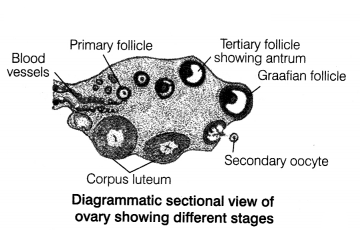
Or
The first stage in the development of a plant zygote is a pre-determined
mode of development (embryogeny). It gives rise to an organised mass of cells
called the embryo, that has the potentiality to form a complete plant. Most
zygotes divide only after certain amount of endosperm is formed to assure proper
nutrition is provided to the developing embryo.
In the majority of angiosperms, the zygote (fertilised egg) divides by an
asymmetric mitotic division and generates two cells with two different
fates.
(i) The smaller daughter cell with dense cytoplasm is situated towards
the chalazal pole. It is called
terminal cell or apical cell or embryonal
cell
(ii) Another comparatively larger daughter cell situated towards the micropylar cell, is called basal cell. This cell divides transversely and gives rise to suspensor cells. The zygote gives rise to the proembryo and subsequently to the globular, heart-shaped and mature embryo.
Though the seeds differ greatly, the early stages of embryo development
(embryogeny) are similar in monocots and dicots.